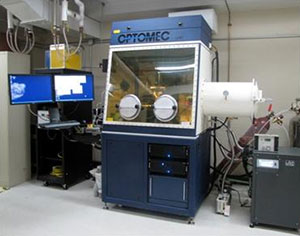Rare-earth elements are finite and, yet, we depend on them for some of our most essential technologies, such as those that involve X-Rays, lasers and magnets. In order to head off the inevitable shortage of rare earth metals, the Critical Materials Institute at the US Department of Energy’s Ames Laboratory is hoping to synthesize new ones with 3D metal printing.

With a LENS MR-7 from Albuquerque-based 3D metal printer manufacturer Optomec, the CMI will develop new metal alloys to replace rare-earth elements found in critical technologies, like clean energy systems. Principal investigator at the Ames Laboratory and the CMI, Ryan Ott, explained how the machine will be used, “Metal 3D printers are slowly becoming more commonplace. They can be costly, and are often limited to small-scale additive manufacturing in industry. But for us, this equipment has the potential to become a very powerful research tool. We can rapidly synthesize large libraries of materials. It opens up a lot of new possibilities.” The Optomec machine divides its metal powder supply into four chambers, fed to the print head in such a way that the metals can be combined into an almost endless number of alloys.
In comparison to traditional combination methods, CMI’s research methodology, using the Optomec technology as well as X-ray analysis from Stanford Synchrotron Light Source (SSRL), will allow the institute to produce these combinations quickly. For instance, the team was able to produce a one-inch long, 0.25-inch diameter stainless steel rod in 20 seconds. Ott describes how much slower such research has been up until now, “The problem is that it’s been typically limited to thin film synthesis. These thin film samples are not always representative of the bulk properties of a material. For example magnetic properties, important to the study of rare earths, are not going to be the same as you get in the bulk material. Now we have the potential to screen through a lot of material libraries very quickly, looking for the properties that best suit particular needs.”
The CMI is a part of the Department of Energy’s Innovation Hubs, a network of institutes devoted to tackling various energy concerns in the country. Alongside the CMI, which is specifically geared towards researching materials necessary for clean energy, are the Energy-Efficient Buildings Hub, Fuels From Sunlight Hub, Nuclear Energy Modeling and Simulation Hub, and the Joint Center for Energy Storage Research Hub. Together, they may help reduce US dependence on fossil fuels, thus reducing greenhouse gas emissions and armed conflict over foreign oil.
Source: Ames Lab


